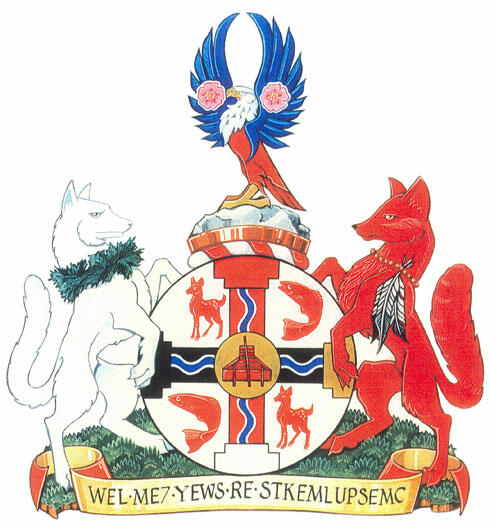The contents of this Register are intended for research purposes only. The heraldic emblems found in the Register may not be reproduced in any form or in any media without the written consent of the Canadian Heraldic Authority and/or the recipient.
Kamloops, British Columbia
Grant of Arms, Supporters, Flags and Badge
June 21, 1996
Vol. III, First Peoples, p. 1
Arms of the Kamloops Indian Band of the Shuswap NationBlazonArgent a cross throughout potent grady of two the vertical arms Gules the horizontal arms Sable charged with a cross wavy Azure edged Argent surmounted at the crossing by a bezant thereon a representation of the supports of a winter lodge of the Kamloops People Gules the end gradients from the chief clockwise Gules Or Argent and Sable the quarters charged first and fourth of a fawn statant second and third of a salmon leaping Gules; SymbolismWhite and red are the historic colours of the Kamloops People. The red and black arms of the cross represent the paths of the spirit and of human beings. The wavy stripes represent the two great rivers which flow through the Kamloops lands. The crossing point represents the heartland and the traditional community dwelling site of the people. It is defined by the gold circle, alluding also to the disc of the sun and the life force it gives. The hundreds of generations of settlement by the Kamloops people at the river’s edge is symbolized by the winter lodge. The fawn and salmon represent the traditional foods of the people and the bounty of the earth. They also refer to the obligation of people to be good stewards of this bounty. At the ends of the cross are four rectangles in the four colours of the cardinal points, also symbolizing the circle of life. |
CrestBlazonOn a rock issuant from a circlet of copper proper an eagle Gules its head and breast Argent beaked and membered Or its wings elevated Azure each charged with a wild rose proper edged Argent; SymbolismThe eagle, in the colours of the Kamloops People, symbolizes watchfulness over people and the carrying of messages to the spirit. Its blue wings refer to the sky, the element in which it lives, and the home of the spirits of ancestors and those yet to come. The wild rose symbolizes the promise of new life. The copper circlet represents the collective wealth of the people and the gifts of chiefs and elders over the generations. The rock outcrop refers to the nearby hills rising above the valley, and especially Mount Paul. |
MottoBlazonWEL ME7 YEWS RE STKEMLUPSEMC; SymbolismThis Shuswap phrase, meaning “The Kamloops people endure and flourish,” describes the Kamloops People, their endurance and their renewed strength. |
SupportersBlazonOn a grassy mound Proper dexter a coyote Argent gorged with a collar of pine branches Vert sinister a fox Gules gorged with a collar of copper beads pendant therefrom three eagle feathers proper; SymbolismThe coyote represents the messenger and teacher who came from the creator spirit. The pine branches are a symbol of thanksgiving of the beings of the earth. The fox represents the peacemaker; the copper collar the gifts of chiefs; and the eagle feathers the strength of the spirit and the power of the people gathered with elders in council. |
Flag of the Chief of the Kamloops Indian Band of the Shuswap NationBlazonPer pale Gules and Argent dexter a coyote’s head sinister a fox’s head contourné both erased at the front and couped at the back conjoined at the party line and counterchanged all within a bordure of copper proper; SymbolismThe coyote is a symbol for the teacher and the fox for the peacemaker, two of the greatest roles of the Chief. The two directions represent the obligation of the Chief to be far seeing in all directions in defence of the community’s welfare, in the search for opportunities, and in the awareness of challenges. The copper border symbolizes the community’s wealth as given by the Chief. |
Eagle Staff for the Chief of the Kamloops Indian Band of the Shuswap NationBlazonA staff with an eagle’s head as finial proper pendant therefrom a vertical banner Gules in the proportions 12:1 fixed to the staff with four attachments the staff wrapped with otter fur at the three openings pendant from the fly edge thirty eagle feathers and attached to the field in groups of two in pale six strips of leather all proper; SymbolismA high-flying bird, the eagle is considered a messenger to the creator. The bird’s flight and keen eyesight allow it to see everything happening on earth. Its head faces forward, as a reminder of the responsibility to ensure the welfare of future generations. The feathers and leather straps represent the bands and groups within the nation, both current and past. The otter fur represents the animals used for clothing and food, and the nation’s link to the land and to water. The wood of the staff, harvested from trees, represents responsible stewardship of resources. |
Badge of the Kamloops Indian Band of the Shuswap NationBlazonOn a plate the head of an elder contourné proper within an orle wavy Azure; SymbolismThe elder represents the source of wisdom and guidance. His hair is in the traditional colours of the Kamloops people. The wavy line represents water, one of the earth’s most important gifts. |
Additional InformationCreator(s)Original concept of Robert D. Watt, Chief Herald of Canada, assisted by the Heralds of the Canadian Heraldic Authority PainterLinda Nicholson CalligrapherSuzzann Wright Recipient TypeCivil Institution |










